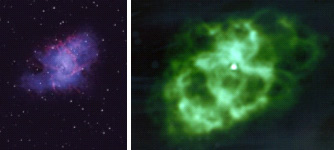Lessons Overview : Pulsar History
In 1967, Jocelyn Bell, a graduate student at Cambridge University, and her research advisor, Anthony Hewish, discovered regular radio pulses coming from the sky with a period of approximately 1.3 seconds. They called the sources of these radio signals pulsars, short for pulsating radio stars. At first, scientists thought that these extremely regular pulses might be caused by an artificial source and they were taken as evidence of intelligent life in the universe. The first pulsar was named LGM, for Little Green Men. As more of these sources were discovered, it was determined that they were caused by natural sources.Supernova remnants were places where scientists would expect to see both neutron stars and black holes. Both very massive, compact objects that had been predicted by theoretical physics at the beginning of the 20th century but had not been observationally confirmed yet. Scientists began searching for pulsars in different supernova remnants. When pulsars were discovered at the hearts of these remnants, physicists were able to determine that these pulses most likely came from neutron stars. Thus, pulsars were one piece of observational evidence which confirmed a hypothesis that grew out of scientific theory.
The Crab Nebula, containing a pulsar, in optical and radio wavelengths.

NOAO / AURA / NSF

NOAO / AURA / NSF